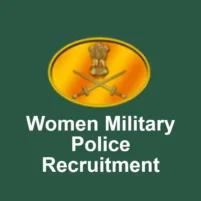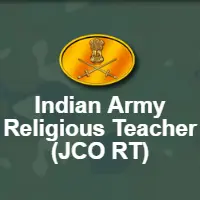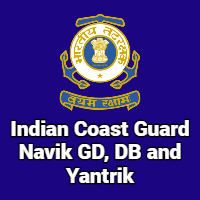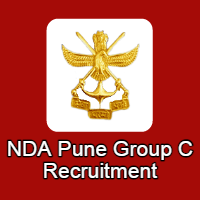Indian Coast Guard has initiated recruitment process for filling up the vacant posts of Navik (General Duty), Navik (Domestic Branch) and Yantrik. Candidates preparing to join the ICG as Navik GD, DB and Yantrik (Mechanical or Electrical or Electronics) will have to go through Online exam, PFT, Medical examination and Document verification under different stages. Aspirants may find here the detailed and latest selection process, physical standards (height, chest and weight), exam pattern and syllabus. ICG Selection Process Navik GD, DB and Yantrik 2023-2024, Physical, PFT, Exam Syllabus, Model Question Paper pdf download etc info is given below.
Indian Coast Guard Selection Procedure
You can check the latest information about the Indian Coast Guard Navik GD, DB and Yantrik Recruitment like online form, vacancy details, eligibility criteria, notification, exam schedule, admit card etc on the link below.
See also: Indian Coast Guard Navik GD DB Yantrik Recruitment 2023-2024
Indian Coast Guard Navik GD, Navik DB and Yantrik selection process consists of online examination (Stage-I), PFT/ Reassessment test/ Initial medical (Stage-II), Final medical at INS Chilka (Stage-III) and Verification of original documents (Stage-IV). The selection of recruits will be based on an all India order of merit on their performance in various stages and the number of vacancies available for the post.
See also: Indian Coast Guard Assistant Commandant Apply 2023-2024
All candidates will be compulsorily subjected to biometric, photo identification and document verification during stage-I, II, III and IV. The details of various stages of the Indian Coast Guard Navik GD, DB and Yantrik selection process are as follows:
Stage I (Written/ Online Examination)
(a) The candidate has to take following tests depending on post applied:
| Sl. | Post Applied | Written Test | Passing Marks | Remarks |
| (i) | Navik (DB) | Section I | 30 (UR/EWS/ OBC)
27 (for SC/ST) |
|
| (ii) | Navik (GD) | Section (I+II) | 30+20=50 (UR/ EWS/ OBC)
27+17= 44 (SC/ST) |
Passing in section I and II separately is compulsory |
| (iii) | Yantrik (Electrical) | Section (I+III) | 30+20= 50 (UR/ EWS/ OBC)
27+17= 44 (SC/ST) |
Passing in section I and III separately is compulsory |
| (iv) | Yantrik (Electronics) | Section (I+IV) | 30+20= 50 (UR/ EWS/ OBC)
27+17= 44 (SC/ST) |
Passing in section I and IV separately is compulsory |
| (v) | Yantrik (Mechanical) | Section (I+V) | 30+20= 50 (UR/ EWS/ OBC)
27+17= 44 (SC/ST) |
Passing in section I and V separately is compulsory |
(b) The details of various section of written/ online exam are as follows:
| Sl. | Name Of Examination | Details of Examination | Subject wise allocation of Questions | Passing Marks | Syllabus |
| (i) | Section I | Maximum Marks – 60
Time – 45 mins. Total no. of Questions – 60 |
Maths – 20
Science – 10 English – 15 Reasoning – 10 GK – 5 |
30 (UR/EWS/ OBC category)
27 (for SC/ST category) |
Class 10th Syllabus |
| (ii) | Section II | Maximum Marks – 50
Time – 30 mins. Total no. of Questions – 50 |
Maths – 25
Physics – 25 |
20 (UR/EWS/ OBC category)
17 (for SC/ST category) |
Class 12th Maths and Physics Syllabus |
| (iii) | Section III | Maximum Marks – 50
Time – 30 mins. Total no. of Questions – 50 |
Electrical Engineering – 50 | 20 (UR/EWS/ OBC category)
17 (for SC/ST category) |
Diploma Level Electrical Engineering syllabus |
| (iv) | Section IV | Maximum Marks – 50
Time – 30 mins. Total no. of Questions – 50 |
Electronics Engineering – 50 | 20 (UR/EWS/ OBC category)
17 (for SC/ST category) |
Diploma Level Electronics Engineering syllabus |
| (v) | Section V | Maximum Marks – 50
Time – 30 mins. Total no. of Questions – 50 |
Mechanical Engineering – 50 | 20 (UR/EWS/ OBC category)
17 (for SC/ST category) |
Diploma Level Mechanical Engineering syllabus |
The question paper for section I, II, III, IV & V will be objective type with four options. The candidate has to choose the correct option. There is no negative marking in the written/ online examination. The detailed syllabus for section I, II, III, IV & V is given below.
Required Documents at Stage I:
1. Coloured printout of E-admit card.
2. Photo ID card as mentioned on application.
3. SC/ST candidates to bring original caste certificate and 02 photocopy of self-attested SC/ST certificate, original train/bus ticket, cancelled cheque leaf for NEFT payment and travel form downloaded from website for claiming TA.
STAGE II (PFT, DV, Re-assessment and Initial Medical Exam)
Based on the performance in the Computer Based Online Examination, a merit list will be prepared and e-admit card for stage-II will be issued as per the vacancies available and ratio decided by ICG. Stage-II involves following test which are only qualifying in nature i.e. either Pass or Fail:
(a) Physical Fitness Test.
The PFT will consist of:
(i) 1.6 Km run to be completed in 7 minutes.
(ii) 20 Squat ups (Uthak Baithak).
(iii) 10 Push-up.
(b) Document verification.
(c) Re-assessment of Inconsistent Performers.
(d) Initial Medical Examination.
Medical Standards:
Height – Minimum 157 Cms (Height standards may be reduced by upto 05 Cms below 157 Cms for candidates having domicile of Assam, Nagaland, Mizoram, Meghalaya, Arunachal Pradesh, Manipur, Tripura, Garhwal, Sikkim and Andaman and Nicobar Islands. Height standards may be reduced by upto 02 Cms for candidates having domicile of Lakshadweep.)
Chest – Minimum 5 Cms expansion
Weight – Proportionate to height and age (±10 percentage acceptable)
Hearing – Normal
Tattoo – Permanent body tattoos are not permitted on any part of the body. However, certain concessions are permitted to candidates belonging to tribal areas communities as declared by the Govt. of India. For other candidates, permanent body tattoos are only permitted on inner face of forearms i.e. from inside of elbow to the wrist and on the reverse side of palm/back (dorsal) side of hand.
Required Documents at Stage II:
1. Coloured printout of “Online application, e-admit card of Stage – I & II”.
2. Photo ID card as mentioned on application.
3. Original documents as submitted in the application form and candidates login after being shortlisted for Stage II.
4. 03 photo copies of all original documents duly self-attested.
5. 20 passport size colour photograph as submitted in application.
6. NOC in original and 4 self-attested photocopy from the employer for candidates presently serving in any government organization (if applicable).
STAGE III (DV, Final Medical and Submission of Documents)
Based on the performance in Stage-I & Stage-II, an all India merit list will be prepared and e-admit card for stage-III (final medicals at INS Chilka) will be issued as per the vacancies available and ratio decided by ICG. Stage-III involves following:
(a) Document verification.
(b) Final Medical at INS Chilka.
(c) Submission of original documents, police verification and other associated forms.
Required Documents at Stage III:
1. Coloured printout of “Online application, Stage-I, II & III of e-admit card”.
2. Original documents as submitted in the application form and candidates login after being shortlisted for Stage II.
3. 03 Photo copies of all original documents duly self-attested.
4. 30 Passport size colour photograph as submitted in application.
5. 10 Colour photographs of specification 3.5 Cms x 2.5 Cms with blue background.
6. Parental willingness certificate (one copy original & 02 Xerox copies).
7. Police verification certificate (one copy original & 02 Xerox copies).
8. Family particular certificate (one copy original & 02 Xerox copies).
9. Character certificate (one copy original & 02 Xerox copies).
10. Willingness certificate (one copy original & 02 Xerox copies).
11. Attestation form (with cadre name) (03 copies original).
12. Aadhaar card (one copy original & 07 Xerox copies).
13. Pan card (one copy original & 07 Xerox copies).
14. NOC in original and 4 self-attested photocopy from the employer for candidates presently serving in any government organisation (if applicable).
15. Photo Id-Card as mentioned in application.
STAGE IV (Selection)
The candidates who clear Stage III and stand in merit as per the vacancies available will be provisionally shortlisted for training at INS Chilka. Candidates are to submit all the original documents and verification of all original documents through Boards/ Universities/ State Government will be carried out by Indian Coast Guard. Candidate will be terminated from service if the documents are reported as not genuine by respective Boards/ Universities/ State Government.
Indian Coast Guard Syllabus Navik GD, DB and Yantrik
The detailed and latest syllabus provided by the Indian Coast Guard (ICG) for the Navik GD, Navik DB and Yantrik exam is as follows:
Section I Syllabus
Science – Nature of Matter, Universe (Planets / Earth / Satellites / Sun ), Electricity and its application. Force and Gravitation, Newton’s Laws Of Motion, Work, Energy and Power. Heat, Temperature, Metals and Non-Metals, Carbon and its Compounds, Measurements in Science, Sound & Wave Motion, Atomic Structure.
Maths – Mathematical Simplification, Ratio and Proportion, Algebric Identities, Linear Equations and Polynomials, Simultaneous Equations, Basic Trigonometry. Simple Mensuration, Geometry, Measures of Central Tendency (Average, Median and Mode). Interest, Profit, Loss and Percentage, Work, Time, Speed and Distance.
English – Passage, Preposition, Correction of sentences, Change active to passive/passive to active voice. Change direct to indirect/indirect to direct, Verbs/Tense/Non Finites, Punctuation. Substituting phrasal verbs for expression, Synonyms and Antonyms, Meanings of difficult words. Use of adjectives, Compound preposition. Use of pronouns.
General Awareness – Geography- Soil, Rivers, Mountains, Ports, Inland, Harbours. Culture and Religion, Freedom Movement, Important National Facts about India, Heritage, Arts and Dance. History, Defence, Wars and neighbours, Awards and Authors, Discoveries, Diseases and Nutrition. Current Affairs, Languages, Capitals and Currencies, Common Names, Full Forms and Abbreviations. Eminent Personalities, National Bird / Animal / Sport / Flower / Anthem / Song/ Flag / Mountains. Sports- Championships / Winners /Terms / Number of Players.
Reasoning – Spatial, Numerical Reasoning & Associative Ability, Sequences, Spellings Unscrambling, Coding and Decoding.
Section II Syllabus
Physics – Physical world and measurement, Kinematics, Laws of Motion, Work, Energy and Power. Newtons laws and applications, circular motion. Motion of System of particles and rigid body, gravitation, Property of Bulk Matter, thermodynamics, behavior of perfect gas and kinetic theory, Oscillation and Waves.
Electrostatics, Current Electricity, Magnetic Effects of current and magnetism, Electromagnetic Induction and alternating currents, Electromagnetic Waves. Optics, Dual Nature of matter and radiation, Atom and Nuclei. Electronic devices, Communicating systems.
Mathematics – Sets, Relations and Functions- Set, Relations and Functions trigonometric functions. Algebra- Principle of Mathematical induction, complex numbers and quadratic equations, linear inequalities, permutation and combinations, binomial theory, sequence and series, Matrices, determinants; Vector And Three Dimensional; Geometry- Vectors, and three dimensional geometry; Liner Programming.
Coordinate Geometry- Straight lines, conic section, introduction to three-dimensional geometry. Calculus- Limits and derivatives, Continuity and differentiability, Applications and derivatives, Integrals, applications of the integrals, differential equations.
Mathematical Reasoning, Probability- Statistics, Probability. Mathematical Simplification, Ratio and Proportion, Algebric Identities, Linear Equations and Polynomials, Simultaneous Equations, Basic Trigonometry.
Relations And Functions- Relations and Functions, inverse trigonometric functions. Simple Mensuration, Geometry, Measures of Central Tendency (Average, Median and Mode).
Section III Syllabus (Electrical Diploma Engineering)
Basic concepts – Concepts of resistance, inductance, capacitance, and various factors affecting them. Concepts of current, voltage, power, energy and their units.
Circuit law – Kirchhoff‘s law, Simple Circuit solution using network theorems.
Magnetic Circuit – Concepts of flux, EMF, reluctance, Different kinds of magnetic materials, Magnetic calculations for conductors of different configuration e.g. straight, circular, solenoidal, etc. Electromagnetic induction, self and mutual induction.
AC Fundamentals – Instantaneous, peak, R.M.S. and average values of alternating waves, Representation of sinusoidal wave form, simple series and parallel AC Circuits consisting of R.L. and C, Resonance, Tank Circuit. Poly Phase system- star and delta connection, 3 phase power, DC and sinusoidal response of R-Land R-C circuit.
Measurement and measuring instruments – Measurement of power (1 phase and 3 phase, both active and re-active) and energy, 2 wattmeter method of 3 phase power measurement. Measurement of frequency and phase angle. Ammeter and voltmeter (both moving oil and moving iron type), extension of range wattmeter, Multimeters, Megger, Energy meter AC Bridges. Use of CRO, Signal Generator, CT, PT and their uses. Earth Fault detection.
Electrical Machines – (a) D.C. Machine- Construction, Basic Principles of D.C. motors generators and their characteristics, speed control and starting of D.C. Motors. Method of braking motor, Losses and efficiency of D.C. Machines.
(b) 1 phase and 3 phase transformers – Construction, Principles of operation, equivalent circuit, voltage regulation, O.C. and S.C. Tests, Losses and efficiency. Effect of voltage, frequency and wave form on losses. Parallel operation of 1 phase /3 phase transformers. Auto transformers.
(c) 3 phase induction motors, rotating magnetic field, principle of operation, equivalent circuit, torque-speed characteristics, starting and speed control of 3 phase induction motors. Methods of braking, effect of voltage and frequency variation on torque speed characteristics, Fractional Kilowatt Motors and Single Phase Induction Motors: Characteristics and applications.
Synchronous Machines – Generation of 3-phase e.m.f. armature reaction, voltage regulation, parallel operation of two alternators, synchronizing, control of active and reactive power. Starting and applications of synchronous motors.
Generation, Transmission and Distribution – Different types of power stations, Load factor, diversity factor, demand factor, cost of generation, inter-connection of power stations. Power factor improvement, various types of tariffs, types of faults, short circuit current for symmetrical faults.
Switchgears and Protection – Rating of circuit breakers, Principles of arc extinction by oil and air, H.R.C. Fuses, Protection against earth leakage / over current, etc. Buchholz relay, Merz-Price system of protection of generators & transformers, protection of feeders and bus bars. Lightning arresters, various transmission and distribution system, comparison of conductor materials, efficiency of different system. Cable- Different type of cables, cable rating and derating factor.
Estimation And Costing – Estimation of lighting scheme, electric installation of machines and relevant IE rules. Earthing practices and IE Rules.
Utilization of Electrical Energy – Illumination, Electric heating, Electric welding, Electroplating, Electric drives and motors.
Basic Electronics – Working of various electronic devices e.g. PN Junction diodes, Transistors (NPN and PNP type), BJT and JFET. Simple circuits using these devices.
Section IV Syllabus (Electronics Diploma Engineering)
Basic concepts – Concepts of resistance, inductance, capacitance, and various factors affecting them. Concepts of current, voltage, power, energy and their units.
Electronic Components & Materials – Conductors, Semi conductor& Insulators; Magnetic materials; Jointing & Cleaning materials for U/G copper cable & OFC; Cells and Batteries (chargeable and non chargeable); Relays, Switches, MCB & Connectors.
Electronic Devices and Circuits – PN Junction diodes, thyristor; Diode and triode circuits; Junction Transistors; Amplifiers; Oscillator; Multivibrator, counters; Rectifiers; Inverter and UPS.
Digital Electronics – Number System & Binary codes; Boolean Algebra & Logic gates; Combinational & Sequential logic circuits; A/D & D/A converter, counters; Memories.
Linear Integrated Circuit – Introduction to operational Amplifier; Linear applications; Non Linear applications; Voltage regulators; Timers; Phase lock loop.
Microprocessor and Microcontroller – Introduction to microprocessor, 8085 microprocessor working; Assembly Language programming; Peripherals & other microprocessors; Microcontrollers.
Electronic Measurements – Measuring systems; Basic principles of measurement; Range Extension methods; Cathode ray oscilloscope, LCD, LED panel; Transducers.
Communication Engineering – Introduction to communication; Modulation techniques; Multiplexing Techniques; Wave Propagation, Transmission line characteristics, OFC; Fundamentals of Public Address systems, Electronic exchange, Radar, Cellular and Satellite Communication.
Data communication and Network – Introduction to data communication; Hardware and interface; Introduction to Networks and Networking devices; Local Area Network and Wide area network; Internet working.
Computer Programming – Programming concepts; Fundamentals of ‘C’ and C ++; Operators in ‘C’ and C ++; Control Statements; Functions, Array String & Pointers, File Structure; Data Structure and DBMS.
Basic Electrical Engineering – DC Circuits; AC fundamentals; Magnetic, Thermal and Chemical effects of Electric current; Earthing- Installation, Maintenance, Testing.
Section V Syllabus (Mechanical Engineering Diploma)
Engineering Mechanics – Resolution of forces, Equilibrium and Equilibrant, parallelogram law of forces, triangle law of forces, polygon law of forces and Lami’s theorem, couple and moment of a couple, condition for equilibrium of rigid body subjected to number of coplanar non-concurrent forces, definition of static friction, dynamic friction, derivation of limiting angle of friction and angle of repose, resolution of forces considering friction when a body moves on horizontal plane and inclined plane.
Calculation of moment of inertia and radius of gyration of : (a) I-Section (b) channel section (c) T-Section (d) L-Section (Equal & unequal lengths) (e) Z-Section (f) Built up sections (simple cases only), Newton’s laws of motion (without derivation), motion of projectile, D’Alembert’s principle, definition law of conservation of energy, law of conservation of momentum.
Material Science – Mechanical properties of engineering materials- tensile strength, compressive strength, ductility, malleability, hardness, toughness, brittleness, impact strength, fatigue, creep resistance. Classification of steels, mild steel and alloy steels. Importance of heat treatment. Heat treatment processes – annealing, normalizing, hardening, tempering, carburizing, nitriding and cyaniding.
Strength of Materials – Stress, strain, stress strain diagram, factor of safety, thermal stresses, strain energy, proof resilience and modules of resilience. Shear force and bending moment diagram– cant leaver beam, simply supported beam, continuous beam, fixed beam. Torsion in shafts and springs, thin cylinder shells.
Machining – Working principle of lathe. Types of lathes – Engine lathe – construction details and specifications. Nomenclature of single point cutting tool, geometry, tool signature, functions of tool angles. General and special operations – (Turning, facing, taper turning thread cutting, knurling, forming, drilling, boring, reaming, key way cutting), cutting fluids, coolants and lubricants. Introduction to shaper, slotter, plainer, broaching, milling and manufacture of gears, heat treatment process applied to gears.
Welding – Welding- Introduction, classification of welding processes, advantages and limitations of welding, principles of arc welding, arc welding equipment, choice of electrodes for different metals, principle of gas (oxy-acetylene) welding, equipment of gas welding, welding procedures (arc & gas), soldering and brazing techniques, types and applications of solders and fluxes, various flame cutting processes, advantages and limitations of flame cutting, defects in welding, testing and inspection modern welding methods, (submerged, CO2, atomic – hydrogen, ultrasonic welding), brief description of MIG & TIG welding.
Grinding & Finishing Process – Principles of metal removal by grinding, abrasives, natural and artificial, bonds and binding processes, vitrified, silicate, shellac rubber, grinding machines, classification: cylindrical, surface, tool & cutter grinding machine, construction details, relative merits, principles of centreless grinding, advantages & limitations of centreless grinding work.
Holding devices, wheel maintenance, balancing of wheels, coolants used, finishing by grinding, honing, lapping, super finishing, electroplating, basic principles – plating metals, applications, hot dipping, galvanizing tin coating, parkerising, anodizing, metal spraying, wire process, powder process and applications, organic coatings, oil base paint, lacquer base enamels, bituminous paints, rubber base coating.
Metrology – Linear measurement- Slip gauges and dial indicators, angle measurements, bevel protractor, sine bar, angle slip gauges, comparators (a) mechanical (b) electrical (c) optical (d) pneumatic. Measurement of surface roughness; methods of measurements by comparison, tracer instruments and by interferometry, collimators, measuring microscope, interferometer, inspection of machine parts using the concepts of shadow projection and profile projection.
Fluid Mechanics & Hydraulic Machinery – Properties of fluid, density, specific weight, specific gravity, viscosity, surface tension, compressibility capillarity, Pascal’s law, measurement of pressures, concept of buoyancy. Concept of Reynold’s number, pressure, potential and kinetic energy of liquids, total energy, laws of conservation, mass, energy and momentum, velocity of liquids and discharge.
Bernoulli’s equation and assumptions, venturimeters, pitottube, current meters. Working principle & constructional details of centrifugal pump, efficiencies– manometric efficiency, volumetric efficiency, mechanical efficiency and overall efficiency, cavitation and its effect, working principle of jet & submersible pumps with line diagrams.
Industrial Management – Job analysis, motivation, different theories, satisfaction, performance reward systems, production, planning and control, relation with other departments, routing, scheduling, dispatching, PERT and CPM, simple problems. Materials in industry, inventory control model, ABC Analysis, Safety stock, re-order, level, economic ordering quantity, break even analysis, stores layout, stores equipment, stores records, purchasing procedures, purchase records, Bin card, Cardex, Material handling, Manual lifting, hoist, cranes, conveyors, trucks, fork trucks.
Thermal Engineering – Laws of thermo dynamics, conversion of heat into work vice versa, laws of perfect gases, thermo dynamic processes- isochoric, isobaric, isothermal hyperbolic, isentropic, polytrophic and throttling, modes of heat transfer, thermal conductivity, convective heat transfer coefficient, Stefan Boltzman law by radiation and overall heat transfer coefficient.
Air standards cycles- Carnot cycle, Otto cycle, Diesel cycle, construction and working of internal combustion engines, comparison of diesel engine and petrol engine. Systems of internal combustion engine, performance of internal combustion engines. Air compressors their cycles refrigeration cycles, principle of a refrigeration plant.
Model Question Paper Navik GD, DB and Yantrik
You can download Model Question Paper for Indian Coast Guard Navik (General Duty), Navik (Domestic Branch) and Yantrik in pdf format directly through the links provided below. You can also download the following Model Paper or Question Paper or Sample Paper for Navik GD, Navik DB and Yantrik posts by visiting on the ICG recruitment website joinindiancoastguard.cdac.in.
See also: Indian Navy MR Syllabus and Exam Sample Question Paper
See also: Indian Navy SSR Syllabus and Exam Sample Paper Download
Yantrik (Electrical) Model Paper
Yantrik (Electronics) Model Paper
Yantrik (Mechanical) Model Paper
Search any information available on this site by the help of the search box above. You may visit later for other latest updates related to ICG Selection Process, Indian Coast Guard Syllabus, Navik GD, DB, Yantrik Exam Pattern etc.




I will join navy coastguard, I have arts stream in 12th class
bhai iska exam offline hota hai ya online ye beta do aap
Sir mera 10th class se 67.14%he .mera admit card ayega???
sir i am a science student i will join to navy coastguard
Comment Text* sir mera 10th me 75% hain kya admit card aa skta hai please sir reply zarur krein.
From Mr Sunil Kumar
Distt-Panipat
Teh-Madlauda
Post office – Atawala
Pin code-132103
State-Haryana
Cast.-(SC) Valmik
Qualifications.-10th,12th(Non-medical)+iti Diploma
With- Tarner Tared
Mob.no.9068251 480,9991741608
My marks is 10th class=500/352{70.4%}
My marks is 12th class=500/300{60%}
Sir plzzz join me
Sir level of %which admit card approach
Sir,
Please help me to found my admit card.
You can download your admit card from the link as provided above using the Registration number or Email ID.
Dear sir, in which month will be release I .C. G
Domestic branch vacancy ?
Sir i have 62% marks in 10th but mera admit card nhi. Aya phir kya karne ka sir
dear sir i have 65% in 12th class commerce site and 82.93% in 10th class can i joine indian coast guard gd bharti , plz give me reply
Sir I have 65% in class tenth can I have the admit card
I have complete 10th
8.8 mark in cbse
But my age is 17
I was born in 23/07/2002
My 10th percentage is 65% so mujhe admit card milega ya nhi catagory sc hai plz reply ki
Sir…meri10 mey 49.%hy or 12th mey 61% mey apply kr skta Hu esmey
sir my 10 th class 70 percentage but my admit card not dowliding why
sir 10th 58% percentage hai main sportman hon national game pole voult
Sir, I have 54 % in matriculation,
Shall I get admit card for written examination of coastguard db?
Sir ma 10pass53% or diploma hy ma ky apply kar sakti hu sir piliss bole
I will join Indian coast guard navik i am 10th 54% parcentage commerce stream 12th pass 52% parcentage continue fy b.com first year i will join to nevik coustagaurd
Pls inform…. upcoming coastguard domestic branch
Registration date ..
I am interested
Next requredmen sir iam complete. Diploma marine sir 12 th 65%sir
Sir me sirf 10th pass 59% me navik yantrik join kar sakte hu
sir mira naam ganesh kumar h m 10 pass hu si uttrakhand se hu my contact no sir 8556846533